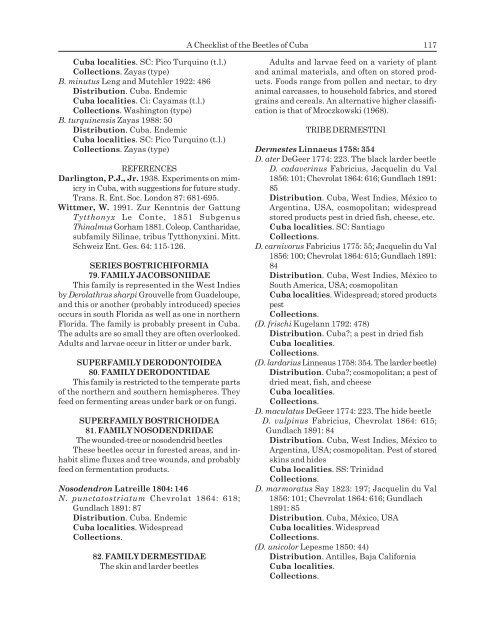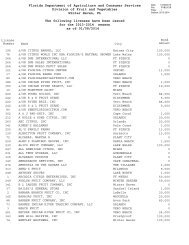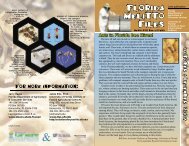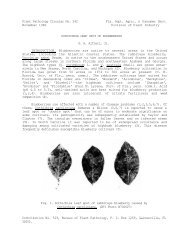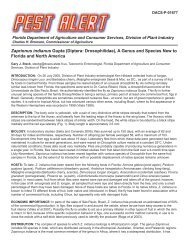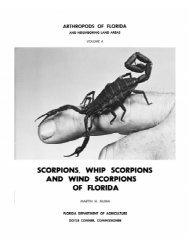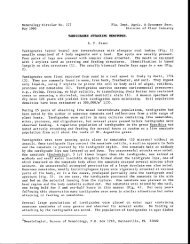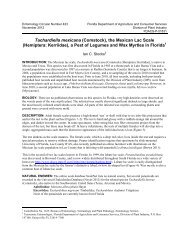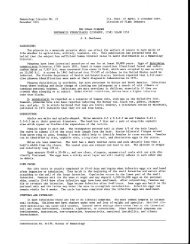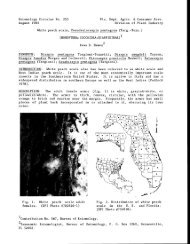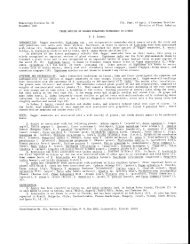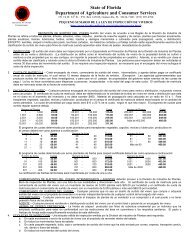A Checklist of the Beetles of Cuba with Data on Distributions and ...
A Checklist of the Beetles of Cuba with Data on Distributions and ...
A Checklist of the Beetles of Cuba with Data on Distributions and ...
You also want an ePaper? Increase the reach of your titles
YUMPU automatically turns print PDFs into web optimized ePapers that Google loves.
<str<strong>on</strong>g>Cuba</str<strong>on</strong>g> localities. SC: Pico Turquino (t.l.)<br />
Collecti<strong>on</strong>s. Zayas (type)<br />
B. minutus Leng <strong>and</strong> Mutchler 1922: 486<br />
Distributi<strong>on</strong>. <str<strong>on</strong>g>Cuba</str<strong>on</strong>g>. Endemic<br />
<str<strong>on</strong>g>Cuba</str<strong>on</strong>g> localities. Ci: Cayamas (t.l.)<br />
Collecti<strong>on</strong>s. Washingt<strong>on</strong> (type)<br />
B. turquinensis Zayas 1988: 50<br />
Distributi<strong>on</strong>. <str<strong>on</strong>g>Cuba</str<strong>on</strong>g>. Endemic<br />
<str<strong>on</strong>g>Cuba</str<strong>on</strong>g> localities. SC: Pico Turquino (t.l.)<br />
Collecti<strong>on</strong>s. Zayas (type)<br />
REFERENCES<br />
Darlingt<strong>on</strong>, P.J., Jr. 1938. Experiments <strong>on</strong> mimicry<br />
in <str<strong>on</strong>g>Cuba</str<strong>on</strong>g>, <str<strong>on</strong>g>with</str<strong>on</strong>g> suggesti<strong>on</strong>s for future study.<br />
Trans. R. Ent. Soc. L<strong>on</strong>d<strong>on</strong> 87: 681-695.<br />
Wittmer, W. 1991. Zur Kenntnis der Gattung<br />
Tytth<strong>on</strong>yx Le C<strong>on</strong>te, 1851 Subgenus<br />
Thinalmus Gorham 1881. Coleop. Cantharidae,<br />
subfamily Silinae, tribus Tytth<strong>on</strong>yxini. Mitt.<br />
Schweiz Ent. Ges. 64: 115-126.<br />
SERIES BOSTRICHIFORMIA<br />
79. FAMILY JACOBSONIIDAE<br />
This family is represented in <str<strong>on</strong>g>the</str<strong>on</strong>g> West Indies<br />
by Derolathrus sharpi Grouvelle from Guadeloupe,<br />
<strong>and</strong> this or ano<str<strong>on</strong>g>the</str<strong>on</strong>g>r (probably introduced) species<br />
occurs in south Florida as well as <strong>on</strong>e in nor<str<strong>on</strong>g>the</str<strong>on</strong>g>rn<br />
Florida. The family is probably present in <str<strong>on</strong>g>Cuba</str<strong>on</strong>g>.<br />
The adults are so small <str<strong>on</strong>g>the</str<strong>on</strong>g>y are <str<strong>on</strong>g>of</str<strong>on</strong>g>ten overlooked.<br />
Adults <strong>and</strong> larvae occur in litter or under bark.<br />
SUPERFAMILY DERODONTOIDEA<br />
80. FAMILY DERODONTIDAE<br />
This family is restricted to <str<strong>on</strong>g>the</str<strong>on</strong>g> temperate parts<br />
<str<strong>on</strong>g>of</str<strong>on</strong>g> <str<strong>on</strong>g>the</str<strong>on</strong>g> nor<str<strong>on</strong>g>the</str<strong>on</strong>g>rn <strong>and</strong> sou<str<strong>on</strong>g>the</str<strong>on</strong>g>rn hemispheres. They<br />
feed <strong>on</strong> fermenting areas under bark or <strong>on</strong> fungi.<br />
SUPERFAMILY BOSTRICHOIDEA<br />
81. FAMILY NOSODENDRIDAE<br />
The wounded-tree or nosodendrid beetles<br />
These beetles occur in forested areas, <strong>and</strong> inhabit<br />
slime fluxes <strong>and</strong> tree wounds, <strong>and</strong> probably<br />
feed <strong>on</strong> fermentati<strong>on</strong> products.<br />
Nosodendr<strong>on</strong> Latreille 1804: 146<br />
N. punctatostriatum Chevrolat 1864: 618;<br />
Gundlach 1891: 87<br />
Distributi<strong>on</strong>. <str<strong>on</strong>g>Cuba</str<strong>on</strong>g>. Endemic<br />
<str<strong>on</strong>g>Cuba</str<strong>on</strong>g> localities. Widespread<br />
Collecti<strong>on</strong>s.<br />
82. FAMILY DERMESTIDAE<br />
The skin <strong>and</strong> larder beetles<br />
A <str<strong>on</strong>g>Checklist</str<strong>on</strong>g> <str<strong>on</strong>g>of</str<strong>on</strong>g> <str<strong>on</strong>g>the</str<strong>on</strong>g> <str<strong>on</strong>g>Beetles</str<strong>on</strong>g> <str<strong>on</strong>g>of</str<strong>on</strong>g> <str<strong>on</strong>g>Cuba</str<strong>on</strong>g> 117<br />
Adults <strong>and</strong> larvae feed <strong>on</strong> a variety <str<strong>on</strong>g>of</str<strong>on</strong>g> plant<br />
<strong>and</strong> animal materials, <strong>and</strong> <str<strong>on</strong>g>of</str<strong>on</strong>g>ten <strong>on</strong> stored products.<br />
Foods range from pollen <strong>and</strong> nectar, to dry<br />
animal carcasses, to household fabrics, <strong>and</strong> stored<br />
grains <strong>and</strong> cereals. An alternative higher classificati<strong>on</strong><br />
is that <str<strong>on</strong>g>of</str<strong>on</strong>g> Mroczkowski (1968).<br />
TRIBE DERMESTINI<br />
Dermestes Linnaeus 1758: 354<br />
D. ater DeGeer 1774: 223. The black larder beetle<br />
D. cadaverinus Fabricius, Jacquelin du Val<br />
1856: 101; Chevrolat 1864: 616; Gundlach 1891:<br />
85<br />
Distributi<strong>on</strong>. <str<strong>on</strong>g>Cuba</str<strong>on</strong>g>, West Indies, México to<br />
Argentina, USA, cosmopolitan; widespread<br />
stored products pest in dried fish, cheese, etc.<br />
<str<strong>on</strong>g>Cuba</str<strong>on</strong>g> localities. SC: Santiago<br />
Collecti<strong>on</strong>s.<br />
D. carnivorus Fabricius 1775: 55; Jacquelin du Val<br />
1856: 100; Chevrolat 1864: 615; Gundlach 1891:<br />
84<br />
Distributi<strong>on</strong>. <str<strong>on</strong>g>Cuba</str<strong>on</strong>g>, West Indies, México to<br />
South America, USA; cosmopolitan<br />
<str<strong>on</strong>g>Cuba</str<strong>on</strong>g> localities. Widespread; stored products<br />
pest<br />
Collecti<strong>on</strong>s.<br />
(D. frischi Kugelann 1792: 478)<br />
Distributi<strong>on</strong>. <str<strong>on</strong>g>Cuba</str<strong>on</strong>g>?; a pest in dried fish<br />
<str<strong>on</strong>g>Cuba</str<strong>on</strong>g> localities.<br />
Collecti<strong>on</strong>s.<br />
(D. lardarius Linneaus 1758: 354. The larder beetle)<br />
Distributi<strong>on</strong>. <str<strong>on</strong>g>Cuba</str<strong>on</strong>g>?; cosmopolitan; a pest <str<strong>on</strong>g>of</str<strong>on</strong>g><br />
dried meat, fish, <strong>and</strong> cheese<br />
<str<strong>on</strong>g>Cuba</str<strong>on</strong>g> localities.<br />
Collecti<strong>on</strong>s.<br />
D. maculatus DeGeer 1774: 223. The hide beetle<br />
D. vulpinus Fabricius, Chevrolat 1864: 615;<br />
Gundlach 1891: 84<br />
Distributi<strong>on</strong>. <str<strong>on</strong>g>Cuba</str<strong>on</strong>g>, West Indies, México to<br />
Argentina, USA; cosmopolitan. Pest <str<strong>on</strong>g>of</str<strong>on</strong>g> stored<br />
skins <strong>and</strong> hides<br />
<str<strong>on</strong>g>Cuba</str<strong>on</strong>g> localities. SS: Trinidad<br />
Collecti<strong>on</strong>s.<br />
D. marmoratus Say 1823: 197; Jacquelin du Val<br />
1856: 101; Chevrolat 1864: 616; Gundlach<br />
1891: 85<br />
Distributi<strong>on</strong>. <str<strong>on</strong>g>Cuba</str<strong>on</strong>g>, México, USA<br />
<str<strong>on</strong>g>Cuba</str<strong>on</strong>g> localities. Widespread<br />
Collecti<strong>on</strong>s.<br />
(D. unicolor Lepesme 1850: 44)<br />
Distributi<strong>on</strong>. Antilles, Baja California<br />
<str<strong>on</strong>g>Cuba</str<strong>on</strong>g> localities.<br />
Collecti<strong>on</strong>s.


